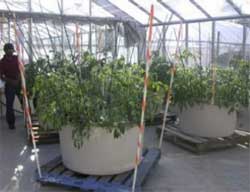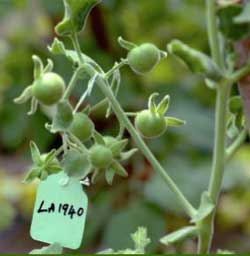Tainan, Taiwan
May 29, 2009
Source:
AVRDC - The World Vegetable
Center - Newsletter
Global food security depends on
genetic diversity. To develop vegetable crops capable of
thriving in the extremes of a changing climate, plant breeders
must evaluate hundreds of crop relatives in search of genes
linked to important agronomic traits such as drought tolerance
and disease resistance. Once identified, these genes can be
built into commercial varieties through conventional breeding or
genetic engineering.
 |
 |
|
Performance of
AVRDC-developed heat tolerant tomato varieties in
Tanzania. |
Drought pool screening
method for comparative assessment of drought
tolerance among plants under the same soil moisture
conditions. |
You could say our breeders are
spoiled for choice: AVRDC maintains the world’s largest public
vegetable genebank with over 56,000 accessions from 150
countries, including over 44,000 accessions of globally
important vegetables and close to 12,000 accessions of
indigenous vegetables. Yet even with a wealth
of germplasm at hand, the right gene or combination of genes may
remain elusive. Although molecular characterization and genetic
diversity analysis of germplasm collections greatly enhances the
efficiency of breeding programs in identifying key genes,
breeding for tolerance to environmental (abiotic) stress
continues to challenge plant breeders. Refining methods to
evaluate phenotype—a plant’s observable physical
characteristics, which are a product of its genes and its
response to the environment it is growing in—can reveal a great
deal about its defense mechanisms.
 |
|
Solanum pennellii accession showing drought tolerance. |
| |
 |
|
Pollen viability test for heat tolerance in tomato
indicating viable pollen. |
The drought pool screening method
used by AVRDC researcher Dr. Rachael Symonds has been useful in
assessing the comparative drought tolerance of different lines
or germplasm accessions under the same soil moisture conditions.
“The drought pool is a simple and practical method that allows a
large number of genotypes to be screened quickly for drought
tolerance,” says Dr. Symonds. “Plants have to compete against
each other for the same soil water, so genotypes with a
competitive advantage are easily identified.” She also has
developed protocols to monitor the transpiration response of
test plants to a progressive water deficit. By applying these
screening protocols, drought tolerance was identified in Solanum
pimpinellifolium and S. pennellii, wild relatives of
cultivated tomatoes.
A prolific tomato line may stop producing fruit when
temperatures start to climb. In high heat, tomatoes
release less pollen, and less viable pollen, which decreases
fruit set and yield. Selecting tomatoes for pollen
viability under heat stress was found to be another valuable
screening method for heat tolerance.
Vegetable cultivars with tolerance to heat and drought would
help improve the livelihoods of resource poor farmers in
developing countries. AVRDC – The World Vegetable Center
together with its partners the
International Crops Research Institute for the Semi-Arid Tropics
(ICRISAT), India;
Leibniz
University of Hannover, Germany;
Central Queensland University
(CQU), Australia; University of
Dar-es-Salaam (UDES), Tanzania; Mikocheni Agricultural
Research Institute (MARI), Tanzania; and Academia Sinica, Taiwan
is
addressing the problem of drought and heat stress in tomato
through a project funded by BMZ/GTZ to improve productivity and
enhance yield stability of tomato in the tropics.
The heat tolerance trials conducted at HQ and at UDES, Tanzania
demonstrated that heat tolerant varieties developed at AVRDC-HQ
are useful sources for Africa as well. In a farmer participatory
evaluation trial conducted by our partner, the University of
Dar-es-Salaam, Tanzania, the AVRDC-developed heat tolerant
tomato varieties were highly preferred by farmers.
by Andreas Ebert and Kadirvel Palchamy
|
|